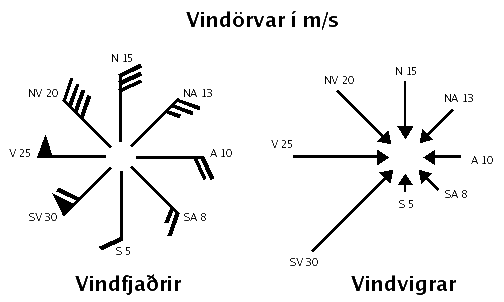Instructions on using Atlantic Ocean forecasts
Keep the following points in mind:
- Forecast maps for the Atlantic Ocean are automatic weather forecasts, made using a computer model.
- View the shipping forecast in addition to the automatic, map-based forecast.
-
Bear in mind that short-term forecasts are more likely to be accurate than long-term forecasts.
Forecast map for the Atlantic Ocean
- The black isobars signify the air pressure, in millibars, at the ocean surface (1 mb = 1 hPa).
- The red, purple and blue isotherms show the temperature at 2 m above the ocean surface. A blue line denotes sub-freezing conditions; a purple line denotes 0°C and; a red line denotes temperatures above freezing.
-
Wind speed is displayed in metres per second (m/s).
-
The angle of the wind barb is indicative of the wind direction.
-
Wind-speed is symbolised by diagonal lines at the end of the barb; a long line represents 5 m/s, a short line 2.5 m/s and a triangle represents 25 m/s.

Temperature forecast:
-
Temperature levels are shown over the Atlantic Ocean in degrees Celsius (°C) at an altitude of about 1,500 m above the ocean surface. This altitude equates to an air pressure of 850 hPa.
-
The temperature at 1,500m altitude provides insight into the advection of warm or cold air.
-
The temperature scale on the image changes according to the temperature range of the forecast.
Precipitation forecast:
-
The map displays a forecast for the cumulative level of precipitation over a 6-hour period.
-
The colour scale denotes precipitation rates. The intensity ranges from 0.5 mm to 30 mm every six hours. Light and heavy precipitation is represented by light-green and purple shading, respectively.
-
Atmospheric pressure at the ocean surface is also shown in millibars (1 mb = 1 hPa).
The sliding bar below the map is used to change the validity time of the forecast
It is possible to change the validity time in many ways:
- It is possible to click anywhere on the bar.
- It is possible to click on the days above the bar to view the noon forecast for a specific day.
- It is possible to click on the time below the bar.
- It is possible to click on the arrows on either side of the bar to view the previous or the next validity time.



